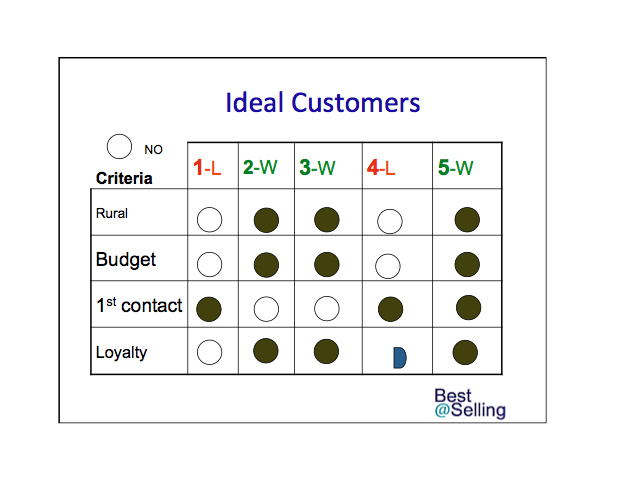Targeting is the selection from all possible potential customers those who are most likely to need and want to buy what you’re selling. It’s not enough to go after an attractive market or one that is large, profitable, growing rapidly or is prestigious. Targeting allows you to exploit your competitive advantage.
Targeting works because if you offer a little of everything to everyone you are vulnerable to a competitor who is more focused on a customer. Why would customers buy from a generalist when they can buy from a specialist who focuses on them?
How to target your ideal customer.
You start to target by answering the question “What do you have that your customers want that they can’t get anywhere else?” The answer might be right before you. You can do a win/loss analysis of previous sales because recent results are the best indicators of future success.
To do the analysis, look at 20 to 100 of your last sales, both won and lost. Then characterize the sales by looking at specific dimensions that are relevant to the sale.
Dimensions could be the size of the customer, who was the decision maker, who was competition, what was the budget, was it a low risk decision, or were there existing relationships. Create a grid and evaluate each dimension for each won or lost sale.
You score each dimension using a circle that gets filled in quadrants. For example, one dimension could be demonstrated loyalty. If your client demonstrated considerable loyalty in a sale, fill the circle entirely. In another sale where your client demonstrated far less loyalty, only a quarter of the circle would be filled. You’ll begin to see a pattern in the grid.

One customer realized that the deals he won were deals that were under $1MM. As a result he changed his targets to focus on getting smaller deals rather than focusing on the larger deals. If you look at the analysis and find that there’s a certain kind of deal you normally lose, unless you’re going to do radically different things, how can you expect to get different results?
What makes it hard.
It’s ironic that the more narrowly you define your target market the fewer the prospects you’ll have, but you will have a greater chance of selling successfully to those targets.
Before limiting a target market, clients often drop everything and focus on the big prospects that come their way. They end up losing the smaller prospects they could have closed. Those are missed opportunities to develop success stories and increase clout with trade journals and suppliers.
Targeting can change their focus to smaller sized accounts with the expectation that with increased credibility in the marketplace in the long term companies would be better positioned to sell to the larger companies.
It’s your choice. Do you want to be great in one market or pretty good in many markets? Pretty good will get you some sales. Great will get you easy sales. Who wouldn’t want that?